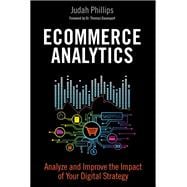- Profit from analytics throughout the entire customer experience and lifecycle
- Make the most of all the fast-changing data sources now available to you
- For all ecommerce executives, strategists, entrepreneurs, marketers, analysts, and data scientists
Judah Phillips shows how to use analysis to improve ecommerce marketing and advertising, understand customer behavior, increase conversion rates, strengthen loyalty, optimize merchandising and product mix, streamline transactions, optimize product mix, and accurately attribute sales.
Drawing on extensive experience leading large-scale analytics programs, he also offers expert guidance on building successful analytical teams; surfacing high-value insights via dashboards and visualization; and managing data governance, security, and privacy.
Here are the answers you need to make the most of analytics in ecommerce: throughout your organization, across your entire customer lifecycle.








